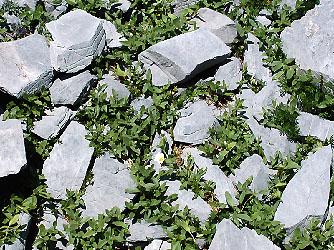 |
|
|
|
|
|
|
Since you are now familiar with several alpine plant communities, you should be able to estimate their species richness. In the graph, the vascular plant species density of eight communities is depicted.
|
As you can see, plant communities in the alpine life zone are not extraordinarily rich in vascular plant species. Therefore, great species richness on the level of whole mountain massifs does not necessarily mean great small-scale species density. However, communities of lower zones are often more species rich; especially grasslands of the subalpine and montane zones may harbour up to 60 different vascular plant species per square metre. |
|
1 - A species-rich grassland in the upper montane zone |
2 - A species-poor community on calcareous scree |
Grasslands, especially those growing under relatively favourable life conditions, are also the plant communities richest in species in the alpine life zone. The communities of harsher environments (ridges, depressions, scree slopes), where one or several environmental factors become extreme, are less rich in species or even very species poor. The environmental filter is selective to such a degree that no more than a few species are able to pass. Therefore, the small species number of these communities is likely to be the result of the lack of species adapted to the hostile conditions. Generally, it seems that vascular plant-species richness of alpine plant communities is a function of the severity of the abiotic environment; the harsher the environment, the smaller the species number. |
29 August 2011 |
||
| |
||

